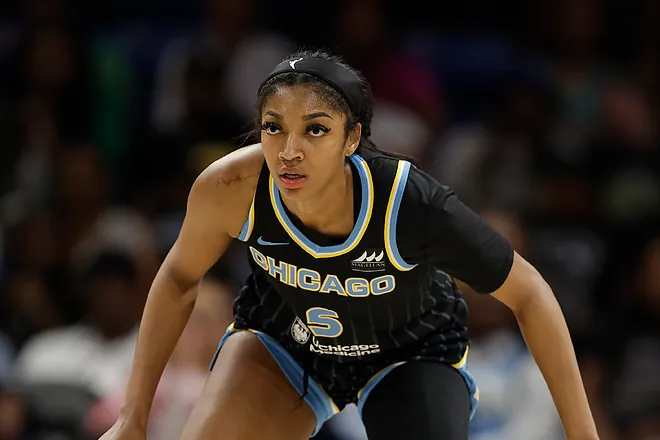In the world of women’s college basketball, few rivalries and comparisons have captured the public’s imagination quite like that between Caitlin Clark and Angel Reese. Both players, exceptional in their own right, have become faces of the sport, inspiring fans with their talent, competitiveness, and relentless drive. However, as Caitlin Clark experiences a notably rough stretch in her performance, fans and analysts alike have taken to social media and sports forums to draw viral comparisons to Angel Reese’s best run yet. This unexpected narrative has sparked a fascinating debate that goes beyond stats, diving deep into player psychology, team dynamics, and the pressures of being elite athletes in the spotlight.
Caitlin Clark, the University of Iowa standout, has long been celebrated for her scoring ability, court vision, and leadership. Known for her fearless shooting and ability to create plays under pressure, Clark has been a highlight reel staple and a symbol of offensive brilliance. Yet, like all athletes, she is not immune to slumps or moments where her performance dips below expectations. Recently, Clark has faced a rough patch, marked by shooting woes, turnovers, and a general struggle to find rhythm on the court. This stretch, while not uncommon in sports, has drawn heightened attention because of the towering presence of Angel Reese, her contemporary and rival.
Angel Reese, a dominant force for LSU, has been on an upward trajectory, showcasing remarkable consistency, defensive prowess, and an intimidating presence in the paint. Her recent performances have been nothing short of spectacular, with Reese hitting career highs in points, rebounds, and impact plays that have helped her team secure critical wins. This surge has solidified her status as one of the premier players in the nation, and fans have eagerly compared her current form to Clark’s struggles, sparking a viral debate about momentum, mental toughness, and who truly embodies the spirit of championship basketball.
The comparison between Clark’s recent difficulties and Reese’s ascendancy isn’t just about numbers; it touches on broader themes. Fans argue that Reese’s ability to maintain peak performance under pressure speaks volumes about her mental resilience and leadership. Meanwhile, Clark’s struggles have been framed as a test of character — can she rebound and regain her form? Social media platforms have exploded with highlight reels juxtaposing Reese’s dominance against Clark’s missed shots and uncharacteristic turnovers, fueling passionate discussions among basketball enthusiasts.
Analyzing Clark’s rough stretch, several factors come into play. First, the weight of expectations on Clark’s shoulders is immense. As a leading scorer and a media darling, every performance is scrutinized, and the pressure to deliver consistently can affect even the most gifted athletes. Opposing teams have also adjusted their defensive strategies specifically to limit her effectiveness, often double-teaming or aggressively contesting her shots. This tactical focus has challenged Clark to evolve her game, something that takes time and can lead to temporary dips in performance.
Moreover, team dynamics and coaching strategies influence individual performances significantly. Iowa’s supporting cast has seen injuries and inconsistent play, placing even more responsibility on Clark. When teammates struggle to provide spacing or reliable scoring options, the burden on a star player increases dramatically. Fatigue and minor injuries can also factor in, affecting a player’s rhythm and confidence. All these elements can contribute to the rough patch Clark is experiencing.
On the other hand, Angel Reese’s current run of dominance reflects a confluence of factors working in her favor. Reese’s physicality, combined with improved offensive skills and a confident mindset, has made her nearly unstoppable. LSU’s coaching staff has tailored their game plan to maximize her strengths, and her teammates have stepped up to complement her style. Reese’s ability to consistently perform at a high level, particularly in clutch moments, has endeared her to fans and analysts alike, who see her as a model of sustained excellence.
The viral comparison also highlights how narratives in sports are shaped by momentum and timing. When a star player hits a slump, the spotlight naturally shifts to their rivals or emerging stars. Reese’s peak coinciding with Clark’s struggles creates a compelling storyline that fans and media gravitate towards. It’s a reminder of the cyclical nature of sports, where highs and lows are part of the journey, and rivalries add layers of drama that elevate the game’s appeal.
Critics of the viral debate caution against oversimplifying the complexities of athlete performance. They argue that comparing two players in different teams, roles, and situations can be misleading. Clark’s skill set is distinct from Reese’s; Clark thrives as a perimeter shooter and playmaker, while Reese excels as a dominant inside presence. Both players bring unique strengths that contribute to their teams in different ways. Understanding these nuances is crucial to appreciating their impact beyond mere statistics or highlight reels.
From a psychological perspective, the pressure and scrutiny faced by both athletes are immense. The expectations of fans, media, and personal ambitions can weigh heavily, influencing performance. Athletes often rely on mental conditioning, support systems, and resilience training to navigate these challenges. Clark’s rough stretch could serve as a pivotal moment in her career—an opportunity to develop greater mental toughness and adapt her game. Similarly, Reese’s ability to capitalize on her peak performance demonstrates the importance of confidence and self-belief.
The viral debate also brings attention to the broader landscape of women’s college basketball. The sport has gained unprecedented visibility and popularity, with players like Clark and Reese leading the charge as household names. Their performances and rivalry have helped elevate the profile of women’s basketball, attracting new fans and inspiring young athletes. The passionate discussions around their careers reflect the growing engagement and enthusiasm for the women’s game.
Looking ahead, both Caitlin Clark and Angel Reese have promising futures. Clark’s talent and determination suggest that her rough stretch is temporary and that she will rebound stronger. Reese’s current dominance positions her as a top contender for awards and professional opportunities. The ongoing narrative between the two will continue to captivate fans, with every game offering new chapters in their evolving story.
In conclusion, Caitlin Clark’s recent rough stretch and the viral comparisons to Angel Reese’s best run encapsulate the thrilling unpredictability of sports. This moment highlights the pressures elite athletes face, the importance of mental resilience, and the impact of team dynamics. It also showcases how narratives shape fan engagement and bring deeper appreciation to the game. As the season progresses, the basketball world will be watching closely to see how these two stars respond—whether Clark can reclaim her brilliance and how Reese continues to build on her remarkable form. Their journeys underscore the essence of competition: highs and lows, challenges and triumphs, all woven into the fabric of sport that fans cherish.



